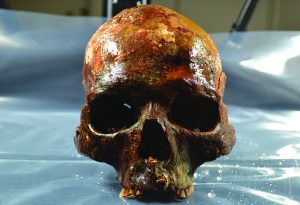Recent excavations at Kanaljorden in Sweden, have revealed disarticulated 8000-year-old human skulls with remains of wooden stakes on which they were mounted, intentionally placed at the bottom of a former lake.

The discovery of the 8000-year-old battered skulls is surrounded by a lot of mysteries. The ancient burial site, excavated between 2009-2013, holds 11 adults – mostly their skulls and a few bones – and nearly the entire skeleton of an infant, who was likely stillborn or died shortly after birth. Two skulls till have pointed wooden stakes through them. Of the remains of at least 11 adults placed on top of the grave, only one had a jawbone. The burial did contain other jawbones, although none of them, except for an infant’s, were human.
Moreover, the excavations also revealed various animal bones, including dismembered jawbones and arms and legs all from the right side of the body. In two skulls wooden stakes were found. One stake had broken, but the other was long measuring around 47 centimetres. It is believed that both likely served as handles or mounts for the skulls.

According to the researchers, it was difficult to identify the sex of some, but at least three of the adults were female and six or seven were males. Seven of the adults, including two of the females, showed signs of blunt-force trauma on their skulls, although the trauma didn’t kill them immediately, because all of the skulls showed signs of healing.
During the Stone Age, the grave would have sat at the bottom of a small lake, meaning that the skulls would have been placed underwater. The researchers believe that the burial site would have been hidden from view during the Stone Age except for a few wooden stakes that may have poked above the water’s edge. The bones were placed on top of these stones in a particular order; archaeologists found the human remains in the centre of the structure, brown bear bones on the southern part and, finally, big game animals, including wild boar, red deer, moose and roe deer, on the southeastern part of the stone packing. The site over time became overrun with reeds, and it turned into a bog. Eventually, a forest grew over the bog, but the area is still watery.
(after Fredrik Hallgren, Sara Gummesson, Anna Kjellström & Live Science)